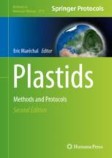Search
Search Results
-
Diversification of Plastid Structure and Function in Land Plants
Plastids represent a largely diverse group of organelles in plant and algal cells that have several common features but also a broad spectrum of...
-
Plastid Transient and Stable Interactions with Other Cell Compartments
Plastids are organelles delineated by two envelopes playing important roles in different cellular processes such as energy production or lipid...
-
Removal of the large inverted repeat from the plastid genome reveals gene dosage effects and leads to increased genome copy number
The chloroplast genomes of most plants and algae contain a large inverted repeat (IR) region that separates two single-copy regions and harbours the...

-
Delayed leaf greening involves a major shift in the expression of cytosolic and mitochondrial ribosomes to plastid ribosomes in the highly phosphorus-use-efficient Hakea prostrata (Proteaceae)
Background and aimsHakea prostrata (Proteaceae) is a highly phosphorus-use-efficient plant native to southwest Australia. It maintains a high...

-
Plastid engineering using episomal DNA
Key messageNovel episomal systems have the potential to accelerate plastid genetic engineering for application in plant synthetic biology.
...
-
Control of plastid inheritance by environmental and genetic factors
The genomes of cytoplasmic organelles (mitochondria and plastids) are maternally inherited in most eukaryotes, thus excluding organellar genomes from...

-
Dig up tall fescue plastid genomes for the identification of morphotype-specific DNA variants
BackgroundTall fescue ( Festuca arundinacea Schreb.) is an important cool-season perennial grass species. Hexaploid tall fescue has three distinct...

-
Plastid DNA is a major source of nuclear genome complexity and of RNA genes in the orphan crop moringa
BackgroundUnlike Transposable Elements (TEs) and gene/genome duplication, the role of the so-called nuclear plastid DNA sequences (NUPTs) in sha**...

-
Plastid-encoded RNA polymerase variation in Pelargonium sect Ciconium
Cyto-Nuclear Incompatibility (CNI), in which there is a mismatch in the interaction between organelles and nucleus, impacts plant species evolution...

-
Research progress on the biosynthesis and delivery of iron–sulfur clusters in the plastid
Iron–sulfur (Fe–S) clusters are ancient protein cofactors ubiquitously exist in organisms. They are involved in many important life processes....

-
Engineering the plastid and mitochondrial genomes of flowering plants
Engineering the plastid genome based on homologous recombination is well developed in a few model species. Homologous recombination is also the rule...

-
H4 acetylation by the NuA4 complex is required for plastid transcription and chloroplast biogenesis
Chloroplast biogenesis is crucial in plant development, as it is essential for the transition to autotrophic growth. This process is light-induced...

-
Modification of Chloroplast Antioxidant Capacity by Plastid Transformation
As immobile organisms, green plants must be frequently challenged by a broad range of environmental stresses. During these constantly adverse...
-
Molecular identification of eight ethnomedicinal plants used by the indigenous communities of Bangladesh through the partial genome sequencing of three plastid markers
The effectiveness of plant-based therapies depends on precise botanical identification. However, tribal communities and practitioners sometimes...

-
The evolution of ephemeral flora in **njiang, China: insights from plastid phylogenomic analyses of Brassicaceae
BackgroundThe ephemeral flora of northern **njiang, China, plays an important role in the desert ecosystems. However, the evolutionary history of...

-
The complete plastid genome and characteristics analysis of Achillea millefolium
Achillea is a crop with Chinese herbal characteristics and horticultural values. Its leaves and flowers contain aromatic oil, and the ripe herb can...

-
Combining BN-PAGE and microscopy techniques to investigate pigment-protein complexes and plastid transitions in citrus fruit
BackgroundChlorophyll and carotenoids, the most widely distributed lipophilic pigments in plants, contribute to fruit coloration during development...

-
Plastid phylogenomics and fossil evidence provide new insights into the evolutionary complexity of the ‘woody clade’ in Saxifragales
BackgroundThe “woody clade” in Saxifragales (WCS), encompassing four woody families (Altingiaceae, Cercidiphyllaceae, Daphniphyllaceae, and...

-
Plastid phylogenomic insights into relationships, divergence, and evolution of Apiales
Main conclusionMembers of Apiales are monophyletic and radiated in the Late Cretaceous. Fruit morphologies are critical for Apiales evolution and...

-
Phylogeny and diversification of genus Sanicula L. (Apiaceae): novel insights from plastid phylogenomic analyses
BackgroundThe genus Sanicula L. is a unique perennial herb that holds important medicinal values. Although the previous studies on Sanicula provided...

